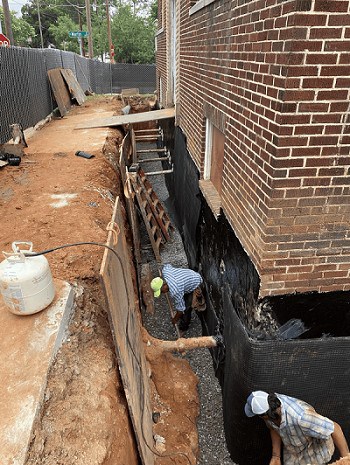Art and Science of Waterproofing Excavation
In the realm of construction and home improvement, waterproofing excavation stands as a vital step in safeguarding structures against the relentless force of water. Whether it’s a foundation, basement, or other subterranean spaces, the process of waterproofing excavation involves strategic planning, precise execution, and a commitment to long-lasting protection. Join us as we delve into the intricacies of waterproofing excavation, exploring its purpose, methods, and the transformative impact it has on fortifying structures against the potential ravages of water intrusion.
The Purpose of Waterproofing Excavation: Waterproofing excavation serves a crucial role in preventing water damage to underground structures. The primary purpose is to create a barrier that shields foundations, basements, and other below-ground spaces from water infiltration. By implementing effective waterproofing measures during excavation, property owners can mitigate the risks associated with water-related issues such as flooding, seepage, and structural damage. This proactive approach not only preserves the integrity of the structure but also contributes to a healthier and more habitable living environment, free from the concerns of dampness, mold growth, and potential compromises to the building’s foundation.
Methods of Waterproofing Excavation: The methods employed in waterproofing excavation vary based on factors such as the type of structure, soil conditions, and the severity of potential water issues. One common technique involves the application of waterproof membranes or coatings to the exterior surfaces of foundations. These barriers create a protective shield, preventing water from penetrating the structure. Another approach is the installation of drainage systems, such as French drains, to redirect groundwater away from the foundation. Additionally, the use of waterproofing sealants on foundation walls and the proper grading of soil around the structure can contribute to effective waterproofing during excavation.
The Role of Proper Drainage: Effective drainage is a cornerstone of successful waterproofing excavation. Poor drainage can lead to the accumulation of water around the foundation, increasing the risk of water infiltration. Proper grading of the soil, ensuring it slopes away from the structure, helps direct surface water away from vulnerable areas. Additionally, the installation of drainage systems, such as weeping tiles or French drains, provides a path for groundwater to move away from the foundation. By incorporating these drainage measures into the waterproofing excavation process, potential water-related issues can be addressed at the source, promoting a dry and resilient foundation.
Choosing the Right Materials: The selection of appropriate waterproofing materials is a critical aspect of ensuring the success of excavation waterproofing. Waterproof membranes, coatings, and sealants should be chosen based on factors such as the type of foundation, soil conditions, and climate. These materials should be durable, flexible, and capable of forming an effective barrier against water infiltration. The use of high-quality materials, combined with proper installation techniques, enhances the longevity and effectiveness of the waterproofing system. Property owners and contractors should collaborate to choose materials that align with the specific needs and challenges of the excavation project.
Professional Expertise and Implementation: While some homeowners may be inclined to tackle waterproofing excavation as a DIY project, the complexities and importance of the task often warrant professional expertise. Experienced contractors possess the knowledge, skills, and equipment needed to execute effective waterproofing measures. They can conduct thorough site assessments, identify potential vulnerabilities, and implement tailored solutions to address specific challenges. Professional waterproofing not only ensures the meticulous execution of excavation work but also provides peace of mind for property owners, knowing that their investment is fortified against the unseen threats of water intrusion.
Conclusion: Waterproofing excavation emerges as a foundational element in the realm of construction, offering a shield against the potential hazards of water infiltration. By understanding the purpose, methods, and key considerations in this process, property owners can fortify their structures against the unseen forces that threaten their integrity. From choosing the right materials to enlisting professional expertise, waterproofing excavation is a transformative step toward creating a resilient and watertight foundation, ensuring that structures stand strong against the test of time and the challenges of water-related issues.


